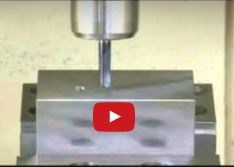Video: Flat-Bottom Drill Versus Conventional
See how a flat-bottom drill tends to shear material as it exists the back side of a workpiece, leaving behind a minimal burr.
Share





Flat-bottom drills are nifty tools. Those that have true 180-degree flat cutting edges can create holes on inclined or curved surfaces without a preliminary center drilling operation to create a start hole. And unlike conventional drills, flat-bottom drills tend to shear material as it exists the back side of a workpiece instead of pushing through, leaving behind a minimal burr.
The video above demonstrates this. Produced by , it shows a slow-motion comparison of a conventional drill and the company’s Aqua Drill Ex Flat completing a through-hole. You can see the tip of the conventional drill pushing through the material, whereas the flat-bottom drill performs more of a shearing operation. The video also shows the flat-bottom drill creating holes in inclined and contoured surfaces without requiring a starter hole.

Related Content
-
How to Mitigate Chatter to Boost Machining Rates
There are usually better solutions to chatter than just reducing the feed rate. Through vibration analysis, the chatter problem can be solved, enabling much higher metal removal rates, better quality and longer tool life.
-
Parts and Programs: Setup for Success
Tips for program and work setups that can simplify adjustments and troubleshooting.
-
Custom Workholding Principles to Live By
Workholding solutions can take on infinite forms and all would be correct to some degree. Follow these tips to help optimize custom workholding solutions.













